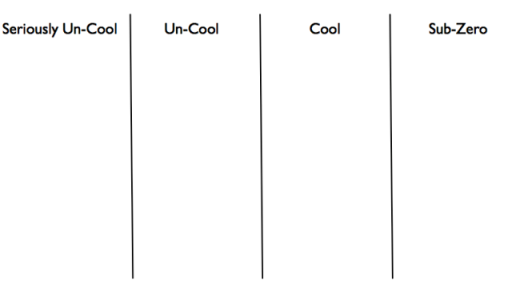Four Retrospective Techniques - Part II
May 07, 2013In the first part of this article, I discussed two Retrospective techniques, the basic one and the starfish Retrospective technique. In this part, I’ll describe two more techniques, the cool wall technique and six thinking hats.
Cool Wall Retrospective Technique
This technique is an inspiration from the Topgear cool wall.
Draw four columns on a whiteboard. Label these columns “Sub-Zero”, “Cool”, “Un-Cool”, and “Seriously Un-Cool”, with seriously un-cool on the far left side and sub-zero on the far right side, as shown in the diagram.

I typically ask the team members to come up with topics and practices that they think are very cool i.e. Sub-zero, cool and seriously un-cool. I give them some time to come up with these ideas and write these down on sticky notes. I gather all the stickies (ideas and practices etc.) on the far left side of the board. Then I pick up one sticky, describe what it says to the team. I move the sticky from left (seriously un-cool) to right (sub-zero) without sticking it on the wall and and ask the team members to vote on where do they think this belongs on the cool-wall. Team members vote with the thumbs-up (or just say “yes, there” etc.). I place the sticky where most the team members think it belongs. I pick up the next one and repeat, until all the stickies are placed on the wall in the relevant columns.
We spend a few minutes talking about the sub-zero and cool things we are doing. Then we move on to talk about the seriously un-cool and un-cool items. I ask the team members to come up with improvement ideas and identify concrete action points for the upcoming Sprint, so the team can move some of the items from seriously uncool and uncool section to cool and subzero sections.
Six Thinking Hats Retrospective Technique
This technique is based on De Bono’s 6 Thinking Hats*. It is a parallel thinking technique, described as “a thinking tool for group discussion and individual thinking”.
Six coloured hats, blue, white, yellow, black, green and red represent a particular way of thinking. The team members describe the Sprint “wearing” one of these hats. At any given time, all team members are wearing the same coloured hat.
I put coloured cards, in five colours, on the whiteboard depicting the coloured hats.
First of all the team “wears” the blue hat. We agree on the objective of the meeting i.e. what do we want out of this session.
Then the team moves on to wear the white hat. The team members talk about the facts (backed up by data) from the Sprint. It’s not about what might have happened, opinions, thoughts or interpretations at this point. Team members may only talk about the facts, based on actual information.
Next, the team moves on to wear the yellow hat. It’s the feel good hat. Now they only talk about the things that went well during the Sprint.
After the feel good hat comes the black hat. While wearing this hat, the team members only talk about the things that didn’t go well in the Sprint i.e. things which are broken.
Then the team wears the green hat. The team members talk about improvement ideas, proposals and solution of the problems they are facing. They talk about all the things they can do to improve.
Finally, the team wears the red hat. Team members describe two (three or more depending on the team size and how much time do you have at your disposal) emotive statements. These may be the issues that have stood out the most or these maybe the ideas for solving a problem they have come up with about during the whole process or earlier. These statements are typically instinctive as team members don’t have much time to come up with these.
At the end, the team spends some time talking about the ideas they came up with while wearing the red hat. They select a few improvement ideas and come up with concrete improvement actions they’ll implement in the next Sprint.
Faisal Mahmood is the author of the book Agile Adoption Mistakes You Must Avoid. Faisal is a Certified Professional Scrum Trainer based in London, UK.
Learn more about Scrum and Agile in one of Scrum Certification Courses.
- De Bono’s 6 Thinking Hats, http://en.wikipedia.org/wiki/Six_Thinking_Hats
